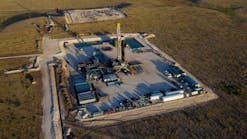Twenty-nine firms awarded stakes in Norway's APA 2016 bid round
Matt Zborowski
Assistant Editor
Twenty-nine companies have been awarded 56 new production licenses on the Norwegian continental shelf as part of Norway's Awards in Predefined Areas (APA) 2016 licensing round. Thirty-three companies were eligible to apply for 148,014 sq km.
Of the licenses, 36 are in the North Sea, 17 in the Norwegian Sea, and 3 in the Barents Sea. Twelve of the production licenses are additional acreage to existing production licenses. Three of the new licenses are stratigraphically divided and only apply to levels below or above a defined stratigraphic limit.
Norwegian state-owned Petoro AS will participate as a licensee and administrator of the state direct financial interest (SDFI) in 13 production licenses.
Fellow Norway firm Statoil ASA led the way, as usual for APA rounds, with interests awarded in 29 licenses and operatorship of 16. Of the 29 licenses, 18 are in the North Sea, 10 in the Norwegian Sea, and 1 in the Barents Sea.
Statoil's award includes one Norwegian Sea commitment well, PL894, where the firm has 40% interest alongside operator Wintershall Norge AS 40% and Petoro 20%. The license includes a work commitment to drill an exploration well within 3 years of the award. Statoil says a potential discovery will have follow-up potential and may add additional volumes to Aasta Hansteen (OGJ Online, Mar. 18, 2015).
"Over the past 2 years we have replenished our portfolio with interesting prospects," said Jez Averty, Statoil's senior vice-president for exploration in Norway and the UK. "This is reflected in the exploration plan we have published for 2017. There we focus on the Barents Sea after high quality awards in the 23rd round and APA 2015. The awards in the APA 2016 round bolsters our position in the Norwegian Sea.
"Our commitment to the Norwegian Sea is demonstrated by the oil and gas discovery in well 6608/10-17 Cape Vulture," he said (OGJ Online, Jan. 17, 2017). "This license was awarded in APA 2015, and the well completed within 1 year of award. This is in line with our ambition to quickly clarify the prospectivity acreage we are awarded."
New firms active
Aker BP ASA, formed earlier this year through the merger of BP Norge AS and Det norske oljeselskap ASA, was offered interests in 29 licenses with operatorship of 13. Of the 21 licenses, 16 are in the North Sea, 4 in the Norwegian Sea, and 1 in the Barents Sea.
Norway-focused startup Wellesley Petroleum AS took 8 licenses with operatorship in 3; Royal Dutch Shell PLC 7 with operatorship in 4; Cairn Energy PLC's Capricorn 7 with operatorship in 2; and ConocoPhillips 6 with operatorship in 3.
Wintershall Holding GMBH took 5 licenses and operatorship in 2. Three of the licenses, including both operatorships, are near Aasta Hansteen. Wintershall now holds around 60 licenses in Norway, with more than 50% as operator.
Faroe Petroleum PLC, Lundin Petroleum AB, and VNG Norge AS each took 4 licenses and will operate 2; MOL Group took 4 licenses with operatorship in 1; and Eni SPA 3 with operatorship in 1. DEA AG, Engie E&P Norge AS, PGNiG SA, Suncor Energy Inc., and Total SA each received 2 licenses with operatorship in 1.
DEA-operated PL896 in the Norwegian Sea is northeast of Skarv field and the firm's operated Dvalin development (OGJ Online, Oct. 3, 2016). During the next few years, DEA plans to participate in 4-5 wells/year both as partner and as operator. Engie-operated PL 817B in the South Viking Graben area of the North Sea, immediately west of Gudrun field, could add additional tie-back production to Gudrun, which would extend the life of the platform, the firm says (OGJ Online, Apr. 7, 2014).
Firms awarded stakes in licenses without operatorship were Concedo ASA with 5, Grupa Lotos SA 5, Point Resources 5, Centrica PLC 4, Fortis Petroleum Corp. AS 4, OMV AG 3, Petrolia Norway AS 2, Repsol SA 2, Edison SPA 1, Idemitsu Kosan Co. Ltd. 1, M Vest Energy AS 1, and Skagen44 AS 1.
Familiarity is key
"This year, interest has been particularly high for areas in the North Sea," said Sissel Eriksen, exploration director of the Norwegian Petroleum Directorate (NPD).
"The APA scheme demonstrates that exploration in mature areas provides further geological understanding and improved data, which creates exciting, new exploration possibilities," Eriksen said.
NPD notes that 16 out of 18 discoveries in 2016 were made in areas comprised by the APA scheme.
"It is an advantage that the geology is quite familiar, though surprises still occur," Eriksen said. "There are both shut down fields and existing fields that are approaching the end of their production in the APA areas, with infrastructure that can be exploited. It is therefore important that we fully explore the surrounding acreage, to ensure potential resources are not lost."
A large portion of activity in the round went to areas around shuttered Frigg field encompassing the UK and Norwegian North Sea, where discoveries have been made in recent years, as well as in areas near earlier discoveries in the Barents and Norwegian Seas.
The offers in APA 2016 require the acquisition of seismic in one area and the drilling of one firm well. Other production licenses are subject to drill-or-drop requirements, giving licensees 1-3 years to decide whether or not to drill an exploration well. If they don't drill the well, the production license becomes void.
In APA 2015, 56 production licenses were awarded to 36 companies (OGJ Online, Jan. 19, 2016). A year earlier, 54 licenses were awarded to 43 companies in APA 2014 (OGJ Online, Jan. 20, 2015).
Up next is Norway's 24th licensing round covering newly opened, frontier acreage on the NCS. Awards are expected before summer. Thirteen firms were offered 10 production licenses in the 23rd licensing round in 2016.
